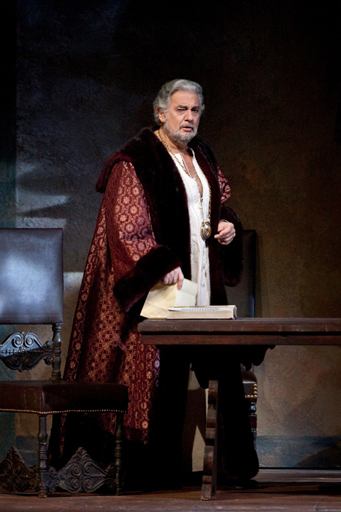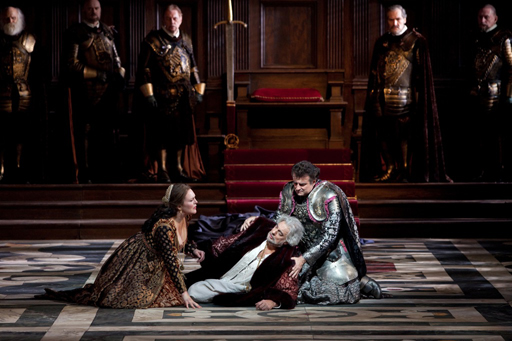All New York’s music lovers, especially those with difficulties getting around, owe a debt of gratitude to Channel 13 for its “Live from Lincoln Center” series: these telecasts are the closest they can get to the concerts and operas they love. The latest “Live from the MET” telecast, taped in February and broadcast on June 20th, presented the new production of Verdi’s “Simone Boccanegra” with Placido Domingo making his debut as a baritone in the title role. Audience expectations ran high, though Domingo has often mentioned that his vocal roots are in the middle register and blossomed into the upper one later. Indeed his voice has always had a remarkably warm, baritonal quality, and, since voices tend to darken with age, he is perhaps merely encouraging a natural vocal development. Nevertheless, after a lifetime as one of the world’s most beloved tenors, taking such a drastic step requires extraordinary courage, and its stunning success makes it an extraordinary achievement.
Domingo’s decision to undertake his first foray into new territory in this vocally and emotionally challenging, complex role was daring but understandable. As Boccanegra, he has moved from portraying an impulsive, young, romantic tenor (like Gabriele Adorno in “Boccanegra”) to a historical character of his own age and maturity. The real Boccanegra was a famous pirate who was twice elected Doge of Genoa; in the opera, he grows from a frustrated lover determined to prove himself a worthy suitor, to an enlightened statesman determined to bring peace and justice to his people.
Verdi wrote “Boccanegra” in 1857; it was a failure: audiences found Piave’s libretto confusing, and the long recitatives boring. In 1881, Verdi revised it, like many of his operas; with a lot of new music and a new text by Boito, it was a resounding success, though the libretto still had weaknesses: the characters’ actions and reactions remained baffling and unbelievable, and events predating the drama were sketched so cursorily that audiences cannot possibly grasp them.
The opera takes place in 14th-century Genoa against a background of convoluted political and personal conflicts that generate misunderstandings, belated revelations and eventual tragedy. But Verdi was less interested in affairs of state than affairs of the heart, and dramatized the characters’ relationships with wonderful duets – not only between soprano and tenor in the obligatory love-duets, but also between basses and baritones in confrontations and reconciliations.
This is a dark opera, dramatically, visually and musically. After an orchestral prelude, played primarily by the lowest strings and winds, the curtain rises on two basses hatching a plot at night. Fiesco, the leading bass, enters, lamenting his daughter’s death. Then Boccanegra, her lover and the father of their illegitimate child, appears; Fiesco hates him, and, in a passionate duet, rebuffs his plea to resolve their enmity. Fast forward 25 years. Boccanegra discovers his long-lost daughter, Amelia; they rejoice, but he inexplicably insists on keeping their relationship secret; soon after, he learns that she loves Adorno, his political enemy. The central scene is set in the Council Chamber. The Doge is trying to persuade the fractious nobles and plebeians to make peace with each other and with Venice; when a riot breaks out in the street, he quells it by sheer force of personality. Meanwhile, Paolo, a vengeful courtier, pours poison into Boccanegra’s water-jug, initiating what must be one of the longest operatic death-scenes: after staggering around (and frequently falling) while singing incredibly difficult music, Boccanegra finally makes peace with Fiesco in another great duet.
The production, conducted by James Levine, is most impressive—visually and musically: the scenery is simple and evocative, the orchestra is splendid as usual, though sometimes too subdued when accompanying the singers; the cast is strong. Verdi did not make things easy for the singers: several start off with a big, demanding aria, requiring some warming up. Adrianne Pieczonka is a beautiful but vocally uneven Amelia; James Morris, in excellent voice, is a majestic Fiesco, Stefan Gaertner a baleful Paolo. Marcello Giordani’s Adorno is heroic in more ways than one: it must take courage to share the stage with the singer who owned your role, yet he seemed inspired rather than intimidated. But it was Domingo who, in the best sense, dominated the stage. He inhabited his part completely, radiating a natural authority that seemed to make everyone more confident and secure. Though his top notes are understandably superior to his low ones, his voice is as focused, expressive and intense as ever. Rarely has there been a more triumphant debut.


